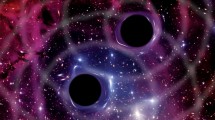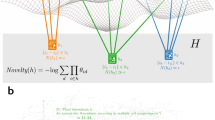Abstract
The relative occurrence of the words “surprising” and “unexpected” in the titles of scientific papers was 11 times more common in 2001–2005 than in 1900–1955. However, papers which had titles containing one of these words did not receive enhanced numbers of citations. Both words (and also adjectives “unusual” and “unfortunately”) are used significantly more frequently in science than in social sciences and humanities. The distribution of the statements of surprise is not random in scientific literature (chemistry journals ranked highest in the number of papers claiming “surprising” or “unexpected” results) and may reflect the level of maturity of a discipline.
Similar content being viewed by others
References
Bensman, S.J. (2007), Garfield and the Impact Factor, Annual Review of Information Science and Technology, 41: 93–155.
Brookes, B. C. (1969), Bradford’s law and bibliography of science, Nature, 224: 953–956.
Cicchetti, D. V. (1991), The reliability of peer-review for manuscript and grant submissions — a cross-disciplinary investigation, Behavioral and Brain Sciences, 14: 119–134.
Danielson, E., Golden, J. H., Mcfarland, E. W., Reaves, C. M., Weinberg, W. H., Wu, X. D. (1997), A combinatorial approach to the discovery and optimization of luminescent materials, Nature, 389: 944–948.
Garfield, E. (1955), Citation indexes for science: A new dimension in documentation through association of ideas, Science, 122: 108–111.
Garfield, E. (1971), How SCI bypasses “the road to scientific oblivion”, Current Contents, Dec. 22: 5–6.
Garfield, E. (1974), On routes to immortality, Current Contents, May 22: 5–7.
Garfield, E. (1980), Bradford’s Law and related statistical patterns, Current Contents, May 12: 5–12.
Garfield, E. (2007), The evolution of the Science Citation Index, International Microbiology, 10: 65–69.
Geysen, H. M., Schoenen, F., Wagner, D., Wagner, R. (2003), Combinatorial compound libraries for drug discovery: An ongoing challenge, Nature Reviews Drug Discovery, 2: 222–230.
Goldberg, J. P., Hellwig, J. P. (1997), Nutrition research in the media: The challenge facing scientists, Journal of the American College of Nutrition, 16: 544–550.
Higgins, A. (2003), Media mania, megalomania and misleading research: the need for caution in scientific publication, Veterinary Journal, 166: 213–214.
Hirsch, J. E. (2005), An index to quantify an individual’s scientific research, Proceedings of The National Academy of Sciences USA, 102: 16569–16572.
Jasienski, M. (1991), Garfield’s demon: citation analysis and development of science in Poland (with particular reference to ecology) [in Polish], Wiadomosci Ekologiczne, 37: 247–263.
Jasienski, M. (1996), Though this be ecology, yet is there method in’t? Global Ecology and Biogeography Letters, 5: 50–51.
Jasienski, M., Thomas, S. C., Bazzaz, F. A. (1998), Blaming the trees: a critique of research on tree responses to high CO2, Trends in Ecology and Evolution, 13: 427.
Jasienski, M. (2006), It’s incredible how often we’re surprised by findings, Nature, 440: 1112.
Lewison, G., Hartley, J. (2005), What’s in a title? Numbers of words and the presence of colons, Scientometrics, 63: 341–356.
Marsh, H. W., Bonds, N. W., Jayasinghe, U. W. (2007), Peer review process: Assessments by applicant-nominated referees are biased, inflated, unreliable and invalid, Australian Psychologist, 42: 33–38.
Miller, C. C. (2006), Peer review in the organizational and management sciences: Prevalence and effects of reviewer hostility, bias, and dissensus, Academy of Management Journal, 49: 425–431.
Murray, D., Schwartz, J., Lichter, S. R. (2001), It Ain’t Necessarily So: How the Media Make and Unmake the Scientific Picture of Reality, Rowman & Littlefield Publishers, Lanham.
Poizat, B. (2001), Some modest comments on the unexpected consequences of a surprising result of Frank Olaf Wagners, Journal of Symbolic Logic, 66: 1637–1646.
Weigold, M. F. (2001), Communicating science — a review of the literature, Science Communication, 23: 164–193.
Author information
Authors and Affiliations
Corresponding author
Rights and permissions
About this article
Cite this article
Jasienski, M. Garfield’s demon and “surprising” or “unexpected” results in science. Scientometrics 78, 347–353 (2009). https://doi.org/10.1007/s11192-007-1979-2
Received:
Published:
Issue Date:
DOI: https://doi.org/10.1007/s11192-007-1979-2




